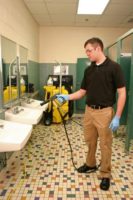 U.S. businesses are starting smaller and staying smaller than in the past. Raymond Sinclair, Ph.D. -- Coordinator of the NIOSH Small Business Assistance and Outreach Program – wants to know what implications that has for worker safety.
U.S. businesses are starting smaller and staying smaller than in the past. Raymond Sinclair, Ph.D. -- Coordinator of the NIOSH Small Business Assistance and Outreach Program – wants to know what implications that has for worker safety.
In a recent NIOSH Science blog post, Sinclair notes that a study reported in the March issue of Monthly Labor Review![]() found that the average “birth size” of new businesses declined from 7.3 to 5.3 employees between 2000 and 2007 – a sharp contrast to companies that had been in existence for seven years or more.
found that the average “birth size” of new businesses declined from 7.3 to 5.3 employees between 2000 and 2007 – a sharp contrast to companies that had been in existence for seven years or more.
The study’s authors suggest that newer businesses are smaller because of an an emphasis on technology over labor -- something Sinclair says has implications for worker health and safety.
“Comparisons of hazards in new businesses by business size would help society understand the implications of the decline in size,” he writes, citing a Canadian study found that businesses that survived five or more years had injury rates that were less than half the rates of businesses that survived only two years or less.
Sinclair identifies relevant research questions:
• Does relying more on technology in new businesses represent added risks for workers, especially when there are fewer of them?
• Are new establishments with fewer employees likely to experience higher levels of occupational stress than those with more employees?
• As average new establishment size declines, do we need new, easy-to-understand and inexpensive ways to assure safe and healthful working conditions such as the Total Worker Health approach and hazard control banding?
Click here to read Sinclair’s complete blog post.
For more information on safety and health in small businesses see the NIOSH Small Business Topic Page.




